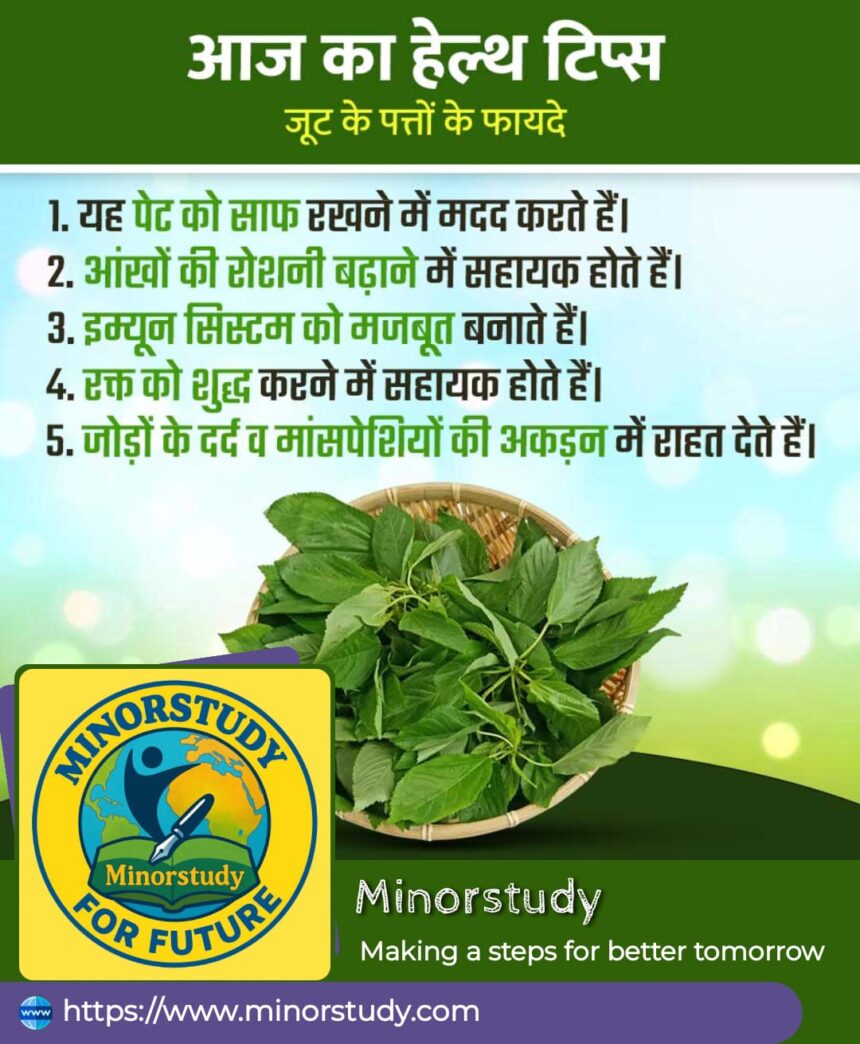🌿 7 Incredible Reasons Why Jute Leaves Are a Hidden Health Treasure You Shouldn’t Ignore
In the world of superfoods, while kale, spinach, and moringa often steal the spotlight, there’s one ancient leafy green that deserves just as much recognition — Jute Leaves. Known by various names like “Patua” in Hindi, “Molokhia” in Middle Eastern countries, and “Ewedu” in West Africa, these nutrient-dense green leaves are packed with medicinal and health-promoting properties.
Jute leaves not only have a long-standing place in traditional medicine and culinary heritage but are also gaining global attention for their immunity-boosting, detoxifying, and anti-inflammatory powers. Let’s explore the history, timeline, health benefits, facts, FAQs, societal significance, and daily life impact of jute leaves, in a human-friendly tone — designed to inform, inspire, and motivate.
🌱 History of Jute Leaves: From Folk Medicine to Superfood
Jute (scientific name: Corchorus olitorius) is widely cultivated for its fiber, but its leaves have been used for centuries for medicinal purposes. The ancient Egyptians revered it for its nourishing qualities — legend says Queen Cleopatra herself consumed Molokhia (jute leaves) regularly for beauty and vitality.
In India, jute leaves were traditionally used in Ayurvedic remedies to treat issues related to digestion, blood purification, and immunity. Similarly, in Africa, it’s used as both food and medicine, cooked into a mucilaginous soup believed to protect against infections, fevers, and joint pain.
🗓️ Timeline – Jute Leaves Through the Ages
| Period/Year | Event |
|---|---|
| Ancient Egypt | Consumed by pharaohs and queens, considered royal food. |
| 1000 BCE | Jute used in Indian subcontinent for both fiber and medicinal foliage. |
| Medieval Era | Arabic medicine documented jute leaves as “Mulukhiyah.” |
| 19th Century | West African tribes use Ewedu soup in postpartum and wellness diets. |
| 20th Century | Studied for antioxidant and anti-inflammatory properties. |
| 21st Century | Declared a superfood in parts of Asia, Africa, and Europe. |
🧾 Amazing Facts About Jute Leaves
🌿 Jute leaves are 80–90% water, making them a low-calorie, hydrating food.
🦴 High in calcium, ideal for bone and joint health.
💪 Contain beta-carotene, vitamin C, iron, and folate – vital for immunity and stamina.
🌍 Found in traditional recipes of over 15 countries, from India to Nigeria to Egypt.
🧬 Jute leaf extract shows promise in reducing oxidative stress and cholesterol.
🔬 Rich in polyphenols and antioxidants – essential for cell repair.
🌿 Both raw and cooked forms are beneficial, though the mucilage when cooked is especially helpful for digestion and joint issues.
💚 Top 7 Health Benefits of Jute Leaves
1. 🌾 Keeps the Stomach Clean
Jute leaves are rich in dietary fiber and mucilage, which improves digestion, reduces constipation, and acts as a gentle natural laxative. It also helps in removing toxins from the gastrointestinal tract.
2. 👁️ Improves Eyesight
Being rich in beta-carotene and vitamin A, jute leaves strengthen the optic nerves, reduce eye strain, and prevent early onset of night blindness or macular degeneration.
3. 🛡️ Strengthens the Immune System
Loaded with vitamin C, iron, and zinc, jute leaves bolster the immune response, fight off infections, and reduce the frequency of colds and flu.
4. 🩸 Purifies the Blood
The iron and antioxidant content in jute leaves helps cleanse the blood, remove free radicals, and support liver function for detoxification.
5. 💪 Relieves Joint Pain and Muscle Stiffness
The anti-inflammatory and mucilaginous properties of cooked jute leaves soothe inflammation, providing relief from arthritis, stiffness, and general body aches.
6. 💆 Improves Skin and Hair Health
Thanks to its antioxidant and vitamin E profile, it supports collagen production, reduces skin damage, and improves hair shine and growth.
7. 🩺 Regulates Blood Sugar and Cholesterol
Jute leaves are low in glycemic index, and the fiber content slows down sugar absorption, aiding diabetic patients and improving cholesterol levels.
❓ Frequently Asked Questions (FAQs)
Q1: Can jute leaves be eaten raw?
Yes, young jute leaves can be consumed raw in salads, though they are more commonly lightly cooked to activate mucilage and maximize health benefits.
Q2: Are there any side effects?
Excessive consumption may cause mild bloating or gas due to high fiber. Pregnant women should consult a doctor before regular intake.
Q3: Where can I buy jute leaves?
They’re commonly found in local markets in South Asia and Africa, or in powdered/dried form online and in herbal stores.
Q4: How are jute leaves used in cooking?
Cooked into soups, stews, stir-fries, or herbal teas. The leaves become slightly slimy when cooked — similar to okra.
Q5: Is there a difference between jute fiber and jute leaves?
Yes. The fiber is used in textiles, while the leaves are for culinary and medicinal purposes.
🎯 Significance in Modern Life
In an era plagued by:
Processed food
Inflammatory diseases
Poor gut health
…jute leaves offer a simple, sustainable, and powerful solution. They’re cost-effective, easy to grow, and boost immunity without pharmaceuticals.
In cultures like India, Nigeria, Egypt, and beyond, jute leaves continue to be a symbol of traditional wellness and nutritional richness.
🧘 Daily Life Impact
Incorporating jute leaves:
Enhances overall energy levels
Aids detox and weight loss journeys
Improves family diets (kids to elders)
Prevents long-term lifestyle disorders
Supports mental clarity by improving gut health
🪷 Observance & Cultural Relevance
While not celebrated with festivals like other herbs, jute leaves are:
Consumed during seasonal fasting periods in Ayurveda
Widely used in postpartum care in Africa
Part of heritage recipes passed down generations
Symbol of sustainable farming and green nutrition
🌼 Wishing Messages & Quotes
🌿 “Let the goodness of jute leaves cleanse your body and soul. Stay healthy, naturally!”
✨ “Eat green, stay lean – include jute leaves in your plate today!”
💚 “Wishing you a life of health, balance, and nourishment – powered by nature’s hidden treasure: Jute Leaves!”
✅ Conclusion: A Green Gift We’ve Overlooked
The power of jute leaves lies in their simplicity. They aren’t exotic or pricey, but rich in ancient wisdom and modern nutrition. If you want:
A clean gut
Better vision
Immune strength
Relief from aches
…jute leaves may be your natural healer.
Let’s return to the roots. Let’s honor nature’s small but mighty gifts. Let’s bring jute leaves back to our plates and pantries.








